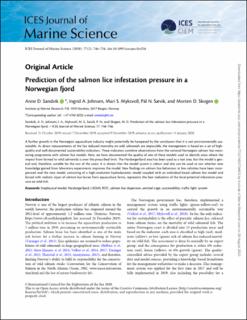| dc.contributor.author | Sandvik, Anne Dagrun | |
| dc.contributor.author | Johnsen, Ingrid Askeland | |
| dc.contributor.author | Myksvoll, Mari Skuggedal | |
| dc.contributor.author | Sævik, Pål Næverlid | |
| dc.contributor.author | Skogen, Morten D. | |
| dc.date.accessioned | 2020-10-16T13:45:01Z | |
| dc.date.available | 2020-10-16T13:45:01Z | |
| dc.date.created | 2020-01-21T17:56:54Z | |
| dc.date.issued | 2020 | |
| dc.identifier.citation | ICES Journal of Marine Science. 2020, 77 (2), 746-756. | en_US |
| dc.identifier.issn | 1054-3139 | |
| dc.identifier.uri | https://hdl.handle.net/11250/2683416 | |
| dc.description.abstract | A further growth in the Norwegian aquaculture industry might potentially be hampered by the conclusion that it is not environmentally sustainable. As direct measurements of the lice induced mortality on wild salmonids are impossible, the management is based on a set of high-quality and well-documented sustainability indicators. These indicators combine observations from the national Norwegian salmon lice monitoring programme with salmon lice models. Here, we have documented the quality of one of these models used to identify areas where the impact from farmed to wild salmonids is over the prescribed limit. The Hardangerfjord area has been used as a test area, but the model is general and, therefore, suitable for the rest of the coast. It is shown that the model system is robust and also can be used to test whether new knowledge gained from laboratory experiments improves the model. New findings on salmon lice behaviour at low salinities have been incorporated and the new model, consisting of a high-resolution hydrodynamic model coupled with an individual-based salmon lice model and forced with realistic input of salmon lice larvae from aquaculture farms, represents the best realization of the local potential infestation pressure on wild fish. | en_US |
| dc.language.iso | eng | en_US |
| dc.title | Prediction of salmon lice infestation pressure in a Norwegian fjord | en_US |
| dc.type | Peer reviewed | en_US |
| dc.type | Journal article | en_US |
| dc.description.version | publishedVersion | en_US |
| dc.source.pagenumber | 746-756 | en_US |
| dc.source.volume | 77 | en_US |
| dc.source.journal | ICES Journal of Marine Science | en_US |
| dc.source.issue | 2 | en_US |
| dc.identifier.doi | 10.1093/icesjms/fsz256 | |
| dc.identifier.cristin | 1779503 | |
| dc.relation.project | Havforskningsinstituttet: 14650 | en_US |
| dc.relation.project | Norges forskningsråd: 244439 | en_US |
| cristin.ispublished | true | |
| cristin.fulltext | original | |
| cristin.qualitycode | 1 | |
